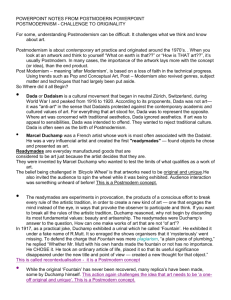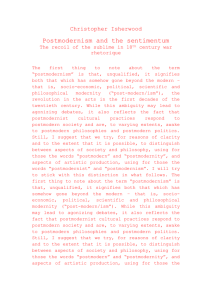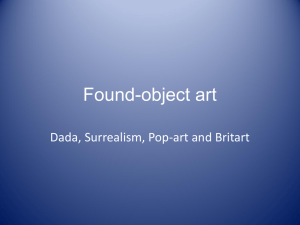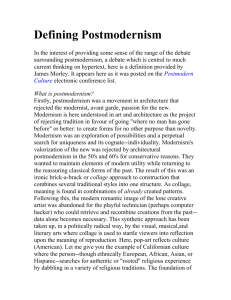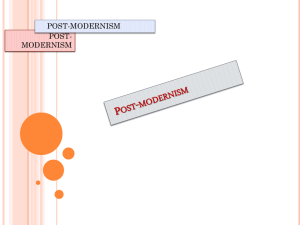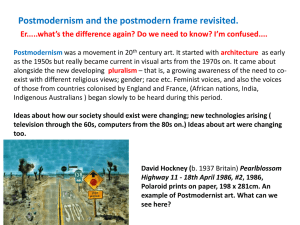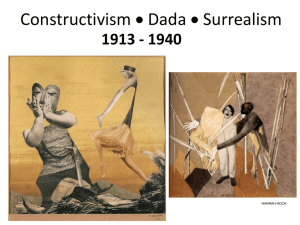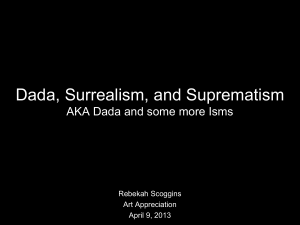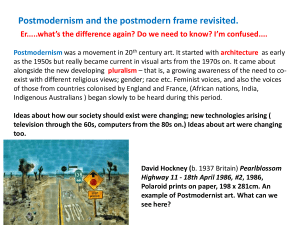AH 101 Research Paper Assignment
advertisement
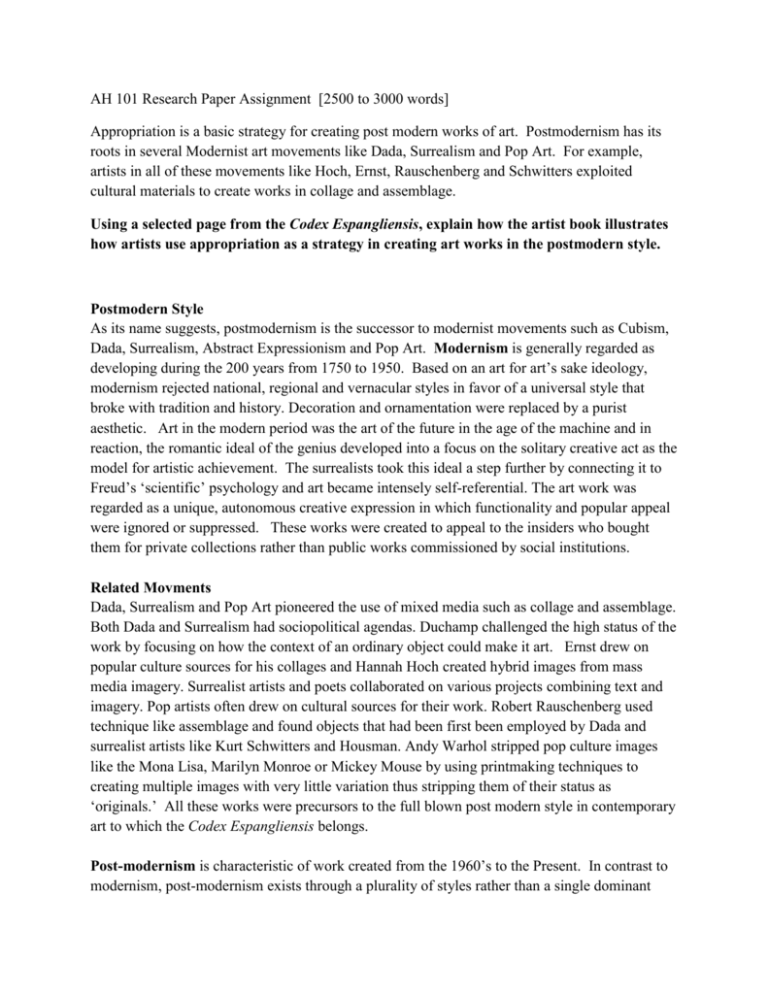
AH 101 Research Paper Assignment [2500 to 3000 words] Appropriation is a basic strategy for creating post modern works of art. Postmodernism has its roots in several Modernist art movements like Dada, Surrealism and Pop Art. For example, artists in all of these movements like Hoch, Ernst, Rauschenberg and Schwitters exploited cultural materials to create works in collage and assemblage. Using a selected page from the Codex Espangliensis, explain how the artist book illustrates how artists use appropriation as a strategy in creating art works in the postmodern style. Postmodern Style As its name suggests, postmodernism is the successor to modernist movements such as Cubism, Dada, Surrealism, Abstract Expressionism and Pop Art. Modernism is generally regarded as developing during the 200 years from 1750 to 1950. Based on an art for art’s sake ideology, modernism rejected national, regional and vernacular styles in favor of a universal style that broke with tradition and history. Decoration and ornamentation were replaced by a purist aesthetic. Art in the modern period was the art of the future in the age of the machine and in reaction, the romantic ideal of the genius developed into a focus on the solitary creative act as the model for artistic achievement. The surrealists took this ideal a step further by connecting it to Freud’s ‘scientific’ psychology and art became intensely self-referential. The art work was regarded as a unique, autonomous creative expression in which functionality and popular appeal were ignored or suppressed. These works were created to appeal to the insiders who bought them for private collections rather than public works commissioned by social institutions. Related Movments Dada, Surrealism and Pop Art pioneered the use of mixed media such as collage and assemblage. Both Dada and Surrealism had sociopolitical agendas. Duchamp challenged the high status of the work by focusing on how the context of an ordinary object could make it art. Ernst drew on popular culture sources for his collages and Hannah Hoch created hybrid images from mass media imagery. Surrealist artists and poets collaborated on various projects combining text and imagery. Pop artists often drew on cultural sources for their work. Robert Rauschenberg used technique like assemblage and found objects that had been first been employed by Dada and surrealist artists like Kurt Schwitters and Housman. Andy Warhol stripped pop culture images like the Mona Lisa, Marilyn Monroe or Mickey Mouse by using printmaking techniques to creating multiple images with very little variation thus stripping them of their status as ‘originals.’ All these works were precursors to the full blown post modern style in contemporary art to which the Codex Espangliensis belongs. Post-modernism is characteristic of work created from the 1960’s to the Present. In contrast to modernism, post-modernism exists through a plurality of styles rather than a single dominant style. Ornamentation and decoration are once again acceptable. Appropriation has become an important artistic strategy with the reusing previous visual styles, recycling materials, and borrowing from many periods in history and many cultural traditions including the work of outsider artists and indigenous world folk traditions. This strategy has lead to the widespread use of collaboration, inter-textual reference, multimedia installations and the blurring of the distinction between words and images. At the same time there is an emphasis on art viewed in context and a consideration of the art work as a consumer product. This practice has introduced complexity, contradiction and ambiguity that tends to intellectualize art works and reflects the movement’s embrace of religious and political issues. Postmodern style is characterized by the use of multiple frames of reference including intertextuality, collaboration, performance and multicultural references. These complex frames of reference result from the use of appropriation and hybridity which blur the boundaries between different cultural systems, historical styles or visual languages is therefore key to understanding the postmodern aesthetic. In postmodernism the art work as an object is often less important than the art work as a text. For the postmodern artist, an actual pipe is interpreted in the same kind of context the picture of a pipe. As a result, postmodern style blurs the essential distinction between a representation and what is represented. The map (the art work) becomes the territory (what it means). Magritte’s painting of a pipe is just as real as the pipe itself. In practice, this paradoxical transference exploits the ways in which the meaning of an art works changes according to the context. Duchamp’s ready mades are a good example of this because ordinary objects become art through the intervention of the artist as appropriator. In post modernism however, the original context/object is no longer relevant in the new context because the work has become integrated into a new text.
